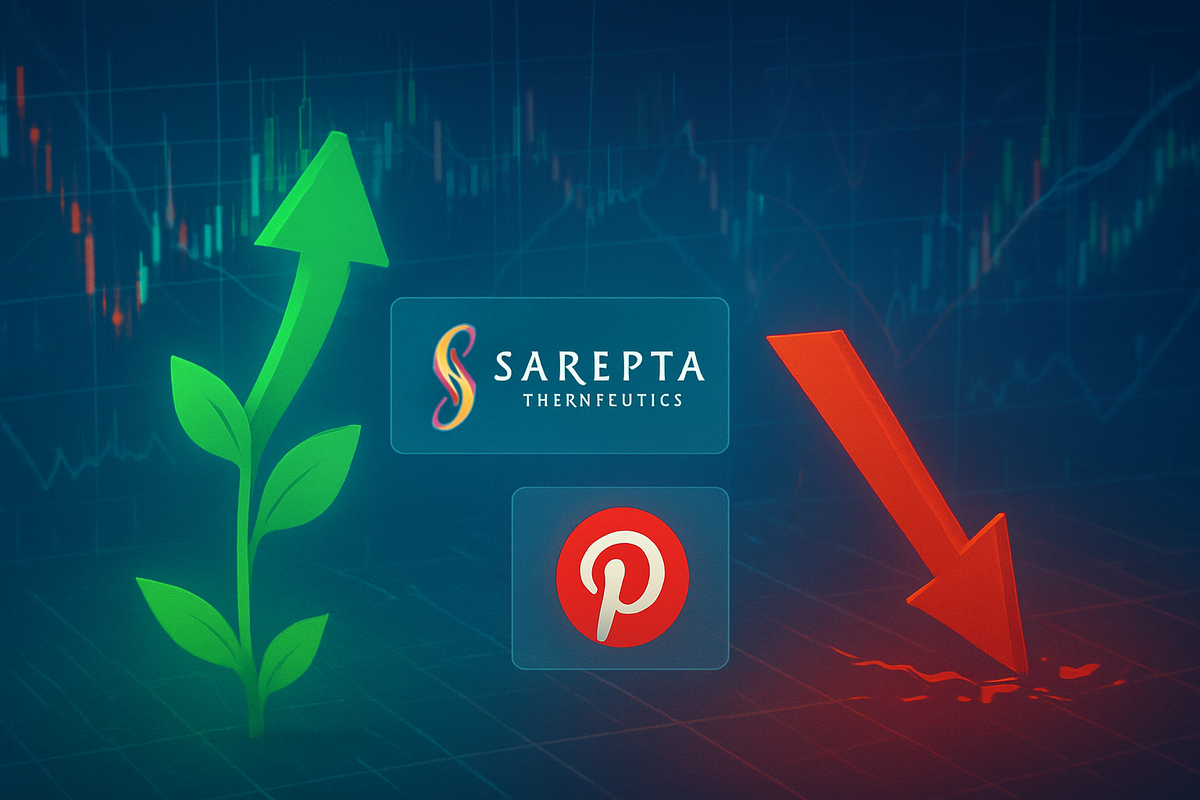
The financial markets are a complex ecosystem, constantly reacting to a myriad of inputs, from macroeconomic data to geopolitical shifts. Among the most closely watched catalysts are the pronouncements of influential Wall Street analysts. These upgrades, downgrades, and price target adjustments often act as immediate market movers, capable of sending a company's stock soaring or plummeting in a single trading session. Recent events surrounding Sarepta Therapeutics (NASDAQ: SRPT) and Pinterest (NYSE: PINS) vividly illustrate this power, showcasing how analyst sentiment can shape investor perception and dictate short-term market movements.
This article delves into the immediate and broader implications of recent analyst actions, examining how Mizuho's evolving stance on Sarepta Therapeutics provided a nuanced narrative of resilience amidst adversity, while Monness Crespi Hardt's decisive downgrade of Pinterest delivered a sharp blow to investor confidence. These contrasting scenarios underscore the critical role analysts play in guiding investment decisions and the often-volatile reactions they trigger across the public markets.
The Nuance of Analyst Influence: Sarepta's Support and Pinterest's Setback
The power of analyst ratings was on full display with two distinct events unfolding in the market. For Sarepta Therapeutics (NASDAQ: SRPT), a biotechnology company focused on gene therapy, the narrative surrounding Mizuho's coverage was less about a single upgrade and more about the sustained influence of a prominent firm's evolving perspective, particularly during challenging times. In March 2025, following a significant stock decline triggered by a reported death related to its gene therapy drug Elevidys, Mizuho analysts reiterated an "Outperform" rating on Sarepta. At a time when Sarepta's stock had fallen dramatically from its 52-week high, Mizuho's continued confidence, suggesting the market reaction might be excessive, served as a crucial bulwark against further collapse, effectively acting as a supportive upgrade by validating the company's long-term potential. This was further solidified on March 30, 2025, when Mizuho Securities maintained a "Buy" rating with a $190 target price. However, as the year progressed, Mizuho's outlook became more cautious. By June 18 and July 2, 2025, while still maintaining an "Outperform" or "Buy" rating, they significantly lowered their price target from $85.00 to $40.00. This gradual adjustment culminated by October 7, 2025, when Mizuho shifted to a "Neutral" rating with a $19.00 price target, ahead of what they anticipated to be a "light" third quarter for the company. This progression highlights how even a maintained positive rating can lose its potency as price targets are slashed, eventually leading to a full downgrade, reflecting a more realistic or conservative outlook.
In stark contrast, the social media platform Pinterest (NYSE: PINS) experienced a more immediate and severe reaction to an analyst downgrade. On November 5, 2025, Monness Crespi Hardt downgraded Pinterest from a "Buy" to a "Neutral" rating. The rationale behind this significant revision was an "uninspiring" outlook, a sentiment likely stemming from the company's recently reported third-quarter results. The market's reaction was swift and brutal: Pinterest shares plunged by approximately 19.94% on the day of the downgrade. This sharp decline underscores the immediate impact a negative re-evaluation from a respected firm can have, especially when it aligns with broader market concerns about a company's growth trajectory or profitability.
Winners and Losers: The Direct Impact on Corporate Fortunes
Analyst revisions directly translate into financial implications for the companies involved, creating immediate winners and losers in the market. For Sarepta Therapeutics (NASDAQ: SRPT), Mizuho's initial and sustained "Outperform" or "Buy" ratings in early 2025, even amidst significant negative news regarding Elevidys, likely helped mitigate a more drastic sell-off. By reiterating confidence, Mizuho provided a level of institutional support that could have prevented the stock from falling even further, thus benefiting existing shareholders by preserving some value. While the later downgrades to "Neutral" and substantial cuts in price targets undoubtedly put pressure on the stock, the initial supportive stance during a crisis could be seen as a win, offering a lifeline when investor sentiment was at its most fragile. However, the subsequent shift to a "Neutral" rating and a significantly reduced price target of $19.00 by October 2025 signals a more cautious outlook, implying that the firm expects limited upside, which could deter new investors and put a ceiling on the stock's recovery in the near term.
On the other hand, Pinterest (NYSE: PINS) clearly emerged as a loser in the immediate aftermath of Monness Crespi Hardt's downgrade. The nearly 20% drop in its share price on November 5, 2025, translated into a significant loss of market capitalization and eroded shareholder value. The "uninspiring" outlook cited by the analysts suggests concerns about Pinterest's ability to drive user growth, engagement, or monetization effectively, especially in a competitive digital advertising landscape. This downgrade could lead to a cascading effect, prompting other analysts to re-evaluate their own ratings, further exacerbating selling pressure. Moreover, a lower stock price can impact employee stock options, make future capital raising more expensive, and potentially signal to advertisers and partners a weakening market position, even if the underlying fundamentals haven't drastically changed overnight. The challenge for Pinterest now is to demonstrate a clear path to renewed growth and profitability to regain investor confidence and reverse the negative sentiment.
Broader Market Implications and Historical Context
The recent analyst actions concerning Sarepta and Pinterest are not isolated incidents but rather reflective of broader trends in how market participants interpret and react to expert opinions. In the highly competitive biotechnology sector, analyst ratings often carry immense weight, particularly for companies like Sarepta (NASDAQ: SRPT) whose fortunes are tied to the success and regulatory approval of a few key drugs. A firm maintaining a positive stance during a drug-related crisis, as Mizuho initially did for Sarepta, can act as a crucial stabilizing force, preventing panic selling and buying the company time to address concerns. Conversely, a shift to "Neutral" or "Sell" can quickly dry up institutional interest, making it harder for the company to attract new capital or even maintain its valuation. This aligns with a broader trend where biotech stocks are particularly sensitive to news flow and expert validation.
For social media and ad-tech companies like Pinterest (NYSE: PINS), analyst downgrades often highlight concerns about slowing user growth, increased competition from rivals like TikTok or Instagram, and the volatility of digital advertising spending. The "uninspiring outlook" for Pinterest reflects a wider industry challenge where platforms must constantly innovate to retain users and advertisers amidst evolving trends and privacy regulations. Historically, sharp downgrades in this sector often signal a re-evaluation of a company's long-term growth potential and its ability to compete effectively. Such events can trigger ripple effects, prompting investors to scrutinize competitors in the social media space, such as Meta Platforms (NASDAQ: META) or Snap Inc. (NYSE: SNAP), for similar vulnerabilities. Regulatory or policy implications are less direct in these specific cases but broader concerns about data privacy and content moderation could indirectly influence analyst sentiment towards the entire social media industry.
What Comes Next: Navigating the Aftermath
The short-term and long-term possibilities for Sarepta Therapeutics (NASDAQ: SRPT) and Pinterest (NYSE: PINS) will largely hinge on their respective responses to these analyst actions and underlying business performance. For Sarepta, the immediate challenge following Mizuho's shift to a "Neutral" rating by October 2025 is to demonstrate consistent positive clinical data for Elevidys and other pipeline candidates, alongside clear commercial execution. Short-term, the stock may remain range-bound or experience further volatility as investors await more definitive news. Long-term, if Sarepta can successfully navigate regulatory pathways, expand market access for its therapies, and diversify its pipeline, it could regain analyst favor. Potential strategic pivots might include focusing on specific patient populations or exploring partnerships to de-risk development. The market opportunity remains substantial for rare disease therapies, but execution will be key.
Pinterest, on the other hand, faces a more immediate need to articulate a compelling growth strategy to counter the "uninspiring outlook" that triggered Monness Crespi Hardt's downgrade. In the short term, the company will need to address investor concerns regarding user engagement and monetization, possibly through stronger Q4 2025 guidance or a clear roadmap for new features and advertising tools. Long-term, Pinterest's ability to innovate its platform, expand into new e-commerce functionalities, and diversify its revenue streams beyond traditional advertising will be crucial. Potential strategic adaptations could include enhanced creator tools, deeper integration with shopping experiences, or international expansion. Market opportunities may emerge if Pinterest can successfully tap into niche advertising markets or leverage its visual search capabilities more effectively. However, the challenge will be to differentiate itself in a crowded social media landscape and prove its growth story is far from over.
A Comprehensive Wrap-Up: Market Vigilance Required
The recent analyst actions surrounding Sarepta Therapeutics (NASDAQ: SRPT) and Pinterest (NYSE: PINS) serve as powerful reminders of the significant influence Wall Street opinions wield over market movements. For Sarepta, Mizuho's initially supportive stance during a crisis, followed by a gradual shift to "Neutral" with reduced price targets, underscores the nuanced and evolving nature of analyst coverage. It highlights how even a maintained positive rating can lose its impact if underlying concerns persist, eventually leading to a more cautious outlook. For Pinterest, Monness Crespi Hardt's direct downgrade and the subsequent nearly 20% stock plunge illustrate the immediate and often brutal consequences of a negative re-evaluation, particularly when it aligns with broader market anxieties about a company's future prospects.
Moving forward, investors should recognize that while analyst ratings provide valuable insights, they are not infallible and should be considered as one data point among many. The market will continue to assess Sarepta's clinical progress and commercial execution for Elevidys, looking for signs of sustained growth and pipeline diversification to justify a more optimistic outlook. For Pinterest, the focus will be on the company's ability to demonstrate renewed user engagement, innovative monetization strategies, and a clear path to accelerated growth in a highly competitive digital advertising environment. The lasting impact of these events will depend on how effectively both companies can execute their strategies and communicate their value proposition to the market. Investors should watch for subsequent analyst reports, management commentary, and, most importantly, the companies' actual financial performance in the coming months as key indicators of their future trajectory.
This content is intended for informational purposes only and is not financial advice








